Karr, John Verdner (Flight Lieutenant)
Killed in Flying Accident 1957-February-16
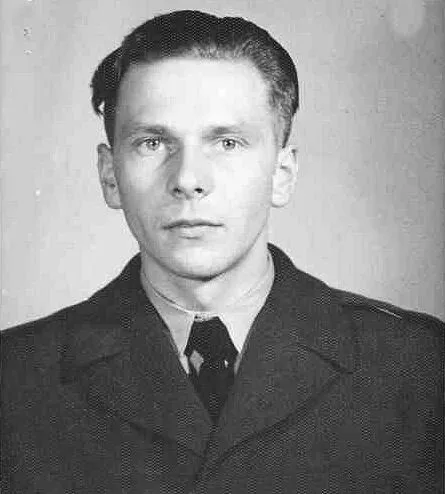

Birth Date: 1928-June-19
Born: Spokane, Washington
Parents: Son of Harold and Alice (nee Christianson) Karr of Wainwright, Alberta.
Spouse: Husband of Mary Shirley Doreen (nee Smith) Karr and father of Mary Susan of Saskatoon, Saskatchewan.
Home: Spokane, Washington
Enlistment: Saskatoon, Saskatchewan
Enlistment Date: 1948-May-25
Service
RCAF
Unit
401 Sqn- Squadron
Mors Celerrima Hostibus Very swift death to the enemy
Base
Rank
Flight Lieutenant
Position
Pilot
Service Numbers
12483
Sabre serial: 23340
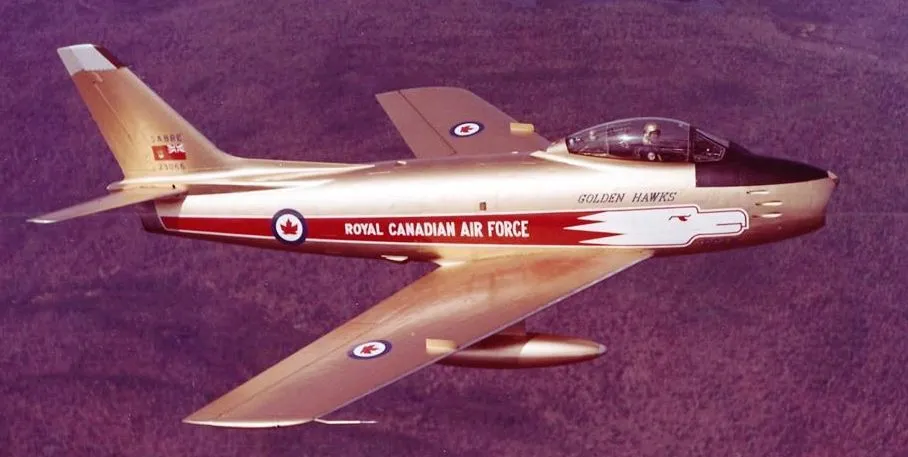
Canadair CL-13 Sabre Mk. 5 (Serial No. 23066), Golden Hawks
The North American F-86 Sabre, sometimes called the Sabrejet, is a transonic jet fighter aircraft. Produced by North American Aviation, the Sabre is best known as the United States' first swept-wing fighter that could counter the swept-wing Soviet MiG-15 in high-speed dogfights in the skies of the Korean War (1950"“1953), fighting some of the earliest jet-to-jet battles in history. Considered one of the best and most important fighter aircraft in that war, the F-86 is also rated highly in comparison with fighters of other eras. Although it was developed in the late 1940s and was outdated by the end of the 1950s, the Sabre proved versatile and adaptable and continued as a front-line fighter in numerous air forces.
Its success led to an extended production run of more than 7,800 aircraft between 1949 and 1956, in the United States, Japan, and Italy. In addition, 738 carrier-modified versions were purchased by the US Navy as FJ-2s and -3s. Variants were built in Canada and Australia. The Canadair Sabre added another 1,815 aircraft and the significantly redesigned CAC Sabre (sometimes known as the Avon Sabre or CAC CA-27), had a production run of 112. The Sabre is by far the most-produced Western jet fighter, with a total production of all variants at 9,860 units.
The fighter-bomber version (F-86H) could carry up to 2,000 lb (907 kg) of bombs, including an external fuel-type tank that could carry napalm. Unguided 2.75-inch (70-millimeter) rockets were used on some fighters on training missions, but 5-inch (127 mm) rockets were later carried on combat operations. The F-86 could also be fitted with a pair of external jettisonable jet fuel tanks (four on the F-86F beginning in 1953) that extended the range of the aircraft. Both the interceptor and fighter-bomber versions carried six 0.50 in (12.7 mm) M3 Browning machine guns with electrically-boosted feed in the nose (later versions of the F-86H carried four 20 mm (0.79 in) cannon instead of machine guns). Firing at a rate of 1,200 rounds per minute, the 0.50-inch guns were harmonized to converge at 1,000 ft (300 m) in front of the aircraft, using armor-piercing (AP) and armor-piercing incendiary (API) rounds, with one armor-piercing incendiary tracer (APIT) for every five AP or API rounds. The API rounds used during the Korean War contained magnesium, which were designed to ignite upon impact, but burned poorly above 35,000 ft (11,000 m) as oxygen levels were insufficient to sustain combustion at that height. Initial planes were fitted with the Mark 18 manual-ranging computing gun sight. The last 24 F-86A-5-Nas and F-86Es were equipped with the A-1CM gunsight-AN/APG-30 radar, which used radar to automatically compute a target's range, which later proved to be advantageous against MiG opponents over Korea. Wikipedia
![]() Wikipedia North American F-86 Sabre
Wikipedia North American F-86 Sabre
![]() YouTube F-86 Sabre Aerobatics - No Music! - Airshow London 2018
YouTube F-86 Sabre Aerobatics - No Music! - Airshow London 2018
F-86 (Canadair Sabre) Part Manual Volume I
F-86 (Canadair Sabre) Part Manual Volume II
F-86 (Canadair Sabre) Maintenance and Diagrams (Partial Document)
Unit Desciption
401 Sqn Mors Celerrima Hostibus ("Ram")
History of the Squadron before and during World War II (Aircraft: Siskin III, Hurricane I, II, Spitfire Vb, IX, IXb)

The roots of the squadron go back to No 81 (Canadian) Squadron RAF in 1918. This squadron was authorized as No 1 Squadron CAF around November 20 of that year, and was disbanded on January 28, 1920. It was re-formed at Jericho Beach (Vancouver), BC on 1 April 1925, and flew forestry and fishery patrols with Curtiss HS-2L flying boats, until it was transferred to the non-military Directorate of Civil Government Air Operationson 1 July 1927, and its service designation lapsed. The squadron was re-created at Trenton, ON in 1937 as No 1 (Fighter) Squadron RCAF. At the time it was equipped with Armstrong Whitworth Siskin III biplane fighters. It moved to Calgary in August 1938 and was re-equipped with Hawker Hurricane Mk 1 fighter aircraft in February 1939. On the outbreak of WWII in September 1939 the squadron was mobilized at St Hubert, QC, before moving to Dartmouth, NS in November. It absorbed No 115 (Fighter) Squadron of the Auxiliary in Montreal before moving to Britain in May 1940. After its aircraft had been modified to make them battle-fit at Middle Wallop, Hampshire and Croydon, Surrey, the squadron joined No 11 Group of RAF Fighter Command at Northolt, Middlesex, in August 1940, and saw action in the Battle of Britain, claiming 30 aircraft destroyed, 8 probably destroyed and 34 damaged. In October 1940 the squadron moved to bases in Scotland before moving briefly to No 12 Group Fighter Command in Driffield, Yorkshire. On March 1st, 1941 it was renumbered No 401 (Fighter) Squadron RCAF, at Digby, Lincolnshire, UK  as part of the Canadian Digby Wing of 12 Group. The Squadron code letters were YO.
as part of the Canadian Digby Wing of 12 Group. The Squadron code letters were YO.
In October 1941 the squadron became again part of 11 Group, flying from several bases in Kent, ending up in September 1942 as part of the Canadian Kenley Wing until January 1943. In February 1941 the squadron converted to Hawker Hurricane Mk II aircraft, then in September of 1941 to Supermarine Spitfire Mk Vb. They flew different Marks of Spitfire for the rest of the war. During the period to early 1943, the squadron participated in fighter sweeps over France, and in RAMROD and RHUBARB operations. From January to May 1943 the squadron was rested at Catterick, Yorkshire and then it rejoined the Kenley Wing. In July 1943 Fighter Command was subsumed into the 2nd Tactical Air Force (TAF), and 401 Sqn was part of the No 126 (RCAF) Wing of No 83 Composite Group. Until June 1944 the squadron flew from Redhill, the Advanced Landing Ground at Staplehurst, Kent, Biggin Hill and Tangmere, Sussex where they continued fighter sweep and RAMROD operations. On and after D-Day the squadron patrolled the beachheads, and 12 days after D-Day the squadron moved to France, to No 4 Base at Beny-sur-Mer, Normandy. Thereafter until the cessation of hostilities the squadron’s Spitfires were employed in fighter and ground attack operations, moving from base to base through France, Belgium, the Netherlands and finally into Germany, as the armies moved northwards. The squadron was finally disbanded at Fassberg, Germany
 on 10 July 1945.
on 10 July 1945.
The squadron shot down 195 enemy aircraft, which made it the top-scoring squadron of the RCAF, and it was the leading squadron in the 2nd TAF with 112 air and 15 ground victories. It held the record for the most sorties flown (12,087). In October 1944 the unit recorded the first victory in the RAF/RCAF over a Me 262 jet fighter. Among the pilots there were 9 Aces (Squadron Leader W.T. Klersy DFC & Bar, Flight Lieutenant J. MacKay DFC & Bar, Flight Lieutenant D.R. Morrison DFC & DFM, Flying Officer G.D. Cameron DFC, Flying Officer J.P.W. Francis DFC, Flying Officer R.R. Bouskill, Flight Lieutenant G.W. Johnson DFC & Bar, Squadron Leader L.M. Cameron DFC, Flying Officer D.B. Dack). Several pilots also claimed triple victories in a single sortie. Aircrew operational losses were 61 pilots, of whom 6 were killed and 28 presumed dead. Aircrew were awarded 15 DFCs, 4 Bars to DFC and 1 DFM. Battle Honours were:Battle of Britain 1940, Defence of Britain 1940-44, English Channel and North Sea 1942, Fortress Europe 1941-44, Dieppe, France, Germany 1944-45Wikipedia, Kostenuk and Griffin
Maps for Movements of 401 Squadron 1940-45
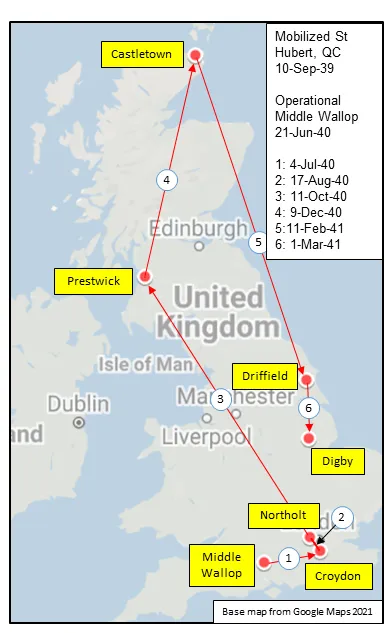
MAP 1: No 1 Squadron RCAF Movements 1940-41 (right-click on image to display enlarged view in new tab)
|
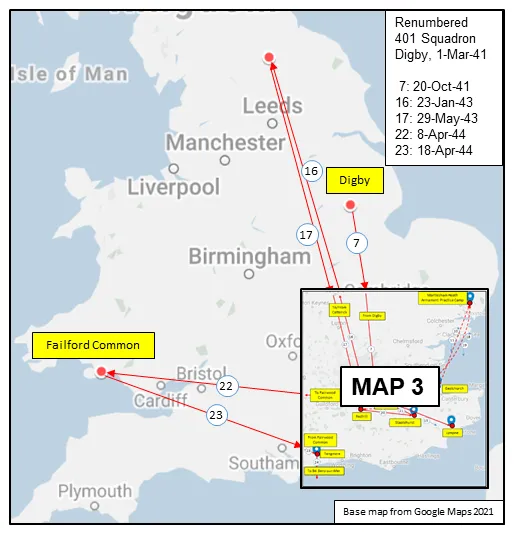
MAP 2: 401 Squadron Movements in UK 1941-44
|

MAP 3: 401 Enlargement Detail of Map 2
|

401 Squadron History Summary 1940-45
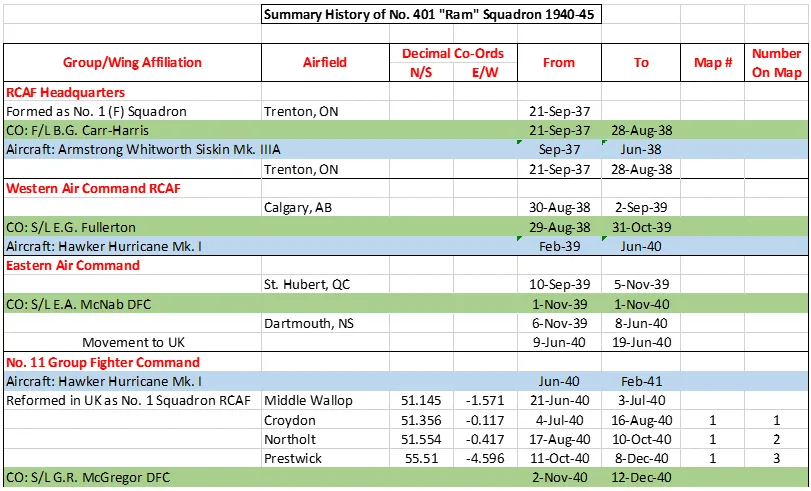
401 Squadron History Summary 1940-45 Page 2
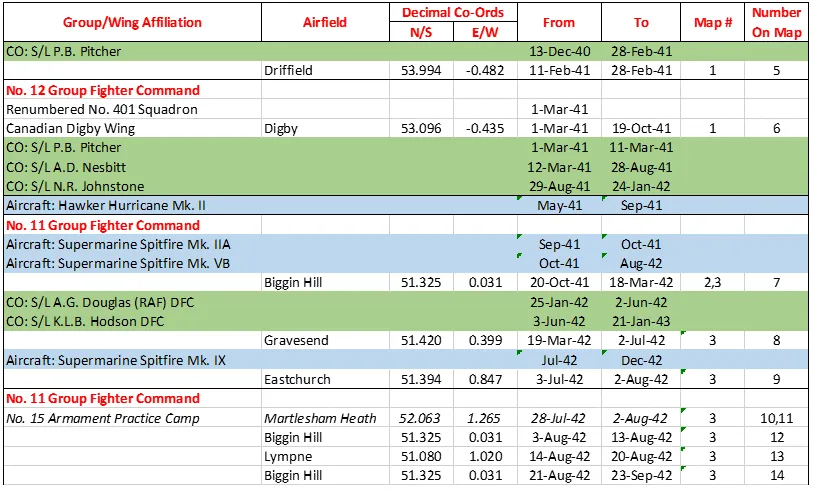
401 Squadron History Summary 1940-45 Page 3
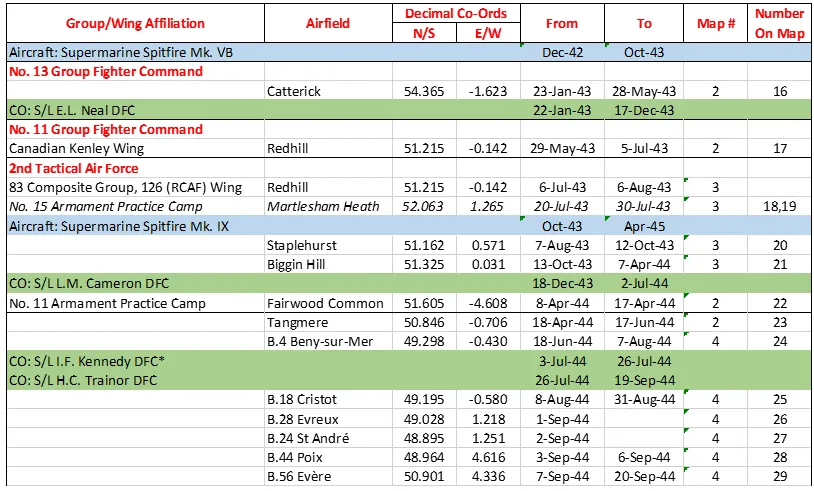
401 Squadron History Summary 1940-45 Page 4

History of the Squadron Post-WWII (Aircraft: Vampire III, Sabre V, Expeditor, Otter, Kiowa, Hornet)
The squadron was reactivated as No 401 (F) Sqn (Aux) on 15 April 1946 at RCAF Station St. Hubert, Quebec  . It was retitled ‘401 "City of Westmount" (F) Sqn (Aux)’ on September 4, 1952. The squadron flew de Havilland Vampire Mk. III and Canadair Sabre Mk. 5 aircraft in a fighter role until October 1958 when it was reassigned to a light transport and emergency rescue role, was re-designated '401 Squadron "City of Westmount" Sqn (Aux)' on November 1, 1958 and re-equipped with Beechcraft Expeditor and de Havilland Otter aircraft. The squadron was awarded a Squadron Standard on 5 May 1962. It was integrated into the Canadian Armed Forces as No 401 “City of Westmount†Air Reserve Squadron in January 1969. It was again re-designated '401 Helicopter Operational Training Squadron' on October 22, 1991. Flying the CH-136 Kiowa helicopter out of St. Hubert, Quebec. 401 Squadron was disbanded on June 23, 1996, after 55 years of operation.
. It was retitled ‘401 "City of Westmount" (F) Sqn (Aux)’ on September 4, 1952. The squadron flew de Havilland Vampire Mk. III and Canadair Sabre Mk. 5 aircraft in a fighter role until October 1958 when it was reassigned to a light transport and emergency rescue role, was re-designated '401 Squadron "City of Westmount" Sqn (Aux)' on November 1, 1958 and re-equipped with Beechcraft Expeditor and de Havilland Otter aircraft. The squadron was awarded a Squadron Standard on 5 May 1962. It was integrated into the Canadian Armed Forces as No 401 “City of Westmount†Air Reserve Squadron in January 1969. It was again re-designated '401 Helicopter Operational Training Squadron' on October 22, 1991. Flying the CH-136 Kiowa helicopter out of St. Hubert, Quebec. 401 Squadron was disbanded on June 23, 1996, after 55 years of operation.
The unit was reactivated as 401 Tactical Fighter Squadron on June 30, 2015, incorporating personnel from No 409 Tactical Fighter Squadron, flying the CF-18 Hornet aircraft. It celebrated its 100th Anniversary in 2018. Its first deployment was to Kuwait for offensive operations during Operation Impact, which is part of the Canadian Government’s approach to the Middle East. The reformed 401 Squadron complements the duties of 409 Tac F Sqn and, assisted by 410 Tactical Fighter (Operational Training) Squadron, deploys tactical fighter forces to meet Canadian and allied defence needs. It is based at Cold Lake, Alberta  as part of RCAF 4 Wing. Under the umbrella of the NORAD mission, fighter crews are on stand-by 24/7 ready to respond to any aerospace threat.
as part of RCAF 4 Wing. Under the umbrella of the NORAD mission, fighter crews are on stand-by 24/7 ready to respond to any aerospace threat.